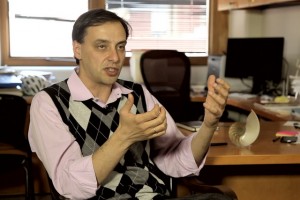The Genome Folding Problem
Associate Professor at MIT Leonid Mirny on the scales of the DNA structure, chromosome interaction, and parall...
Schizophhrenia is a tenacious disease. It’s one of the major psychoses along with psychotic depression. It affects a vast number of people. Understanding of it has grown enormously over the past century, and yet there are some great mysteries about the nature of the disease, its aetiology, what caused it and, indeed, how to cure it. So, typically it’s being regarded as a neurodevelopmental disorder in the sense that it has a characteristic age of onset (usually in the late twenties), more in men than in women, with a very characteristic progression into various flavors of schizophrenia, which people can either diagnose or categorize in terms of particular sources of schizophrenia. Some people prefer to look at clusters of symptoms, and in terms of expression and different dimensions or patterns of symptoms – they themselves fluctuate during the course of the illness.
So, there’s a long-long history of disintegration and dysconnection of the distributed processing associated with the schizophrenia. Modern-day variants of that hypothesis have emerged under the rubric of a dysconnection hypothesis, borrowing the notion from dysconnection syndromes in neurology. But the key difference between modern versions of the dysconnection hypothesis and classical neurological sejunction-like ideas just to remind that this sejunction notion is an anatomical disruption, a cutting of the wires. Whereas modern-day formulations are a little bit more subtle, these are functional dysconnections.
So if you imagine the brain like a radio with all sorts of specialized components, functionally specialized for doing this bit and that bit (of whatever a radio does in terms of receiving the information and producing outputs), and all the wires as the connections, the anatomical, or sejunction, dysconnection would be a disruption of the wires or failure of the wires to find their proper targets. Whereas the functional dysconnection, the dysconnection hypothesis today, would say «no, it’s your transistors that are broken, it’s the effect of the messages passed down the wires on the local processing that’s broken». So, from the perspective of the brain and systems neuroscience and molecular biology, this would be a subtle but devastating failure of synaptic processing that mediates the functional integration or the connectedness of distributed brain processing. By synaptic failure I mean the mechanisms that allow one brain cell, or neuron, to talk to another. The processes that are in play in gathering messages from pre-synaptic contacts, contacts from either local neurons or distant parts of the brain, and integrating them properly in a context-sensitive fashion, so that each neuron can emit the correct response and pass messages on to the next part of the brain.
So, that contextual aspect speaks exactly to the transistor analogy. It is not the fact that the connection is broken, it’s just not gated properly. In biology that will be known as a neuromodulatory failure. So, immediately we are now in the game of trying to identify, from a functional perspective (under the dysconnection hypothesis), how might you break a synapse, not that you’re removing it, but you’re stopping it contextualizing itself properly, chewing itself to the right strength in this moment given all the neuronal activity that’s going on around that region and other part of the brain. There are lots of mechanisms that are responsible for setting that correct strength, the same way the transistor was set the correct conductance to ensure the right sort of message passing.
We have classical neuromodulatory systems, such as dopamine and serotonin. And dopamine has been particularly interesting, of course, because most efficacious antipsychotic medication that has traditionally been used to treat schizophrenia directly affects dopamine receptors. We also have special receptors – NMDA-receptors – on synapses that have this peculiar nonlinear gating behavior that gives them the capacity to act like a small transistor, to respond in a non-linear way (so that only receptors, the ion channels –they are responsible for controlling – are only in play at certain levels of activational depolarization). So, there are whole theories now that look at the interaction between, say, dopamine receptor activation and NMDA function, and NMDA-receptors are driven by glutamates, so there is a glutamate theory of schizophrenia. In fact, for every neurotransmitter that can affect this neuromodulatory gating there is a synaptic variance schizophrenia, and evidence for, evidence for an abnormality in this particular neurotransmitter system.
There are also other non-neurochemical mechanisms of this gain control, and they speak to ideas about the neural dynamics setting their own excitability. So that if lots of messages arrive at the same time and in synchrony, they will be more potent in eliciting a postsynaptic nervous response than if they arrive asynchronously or slowly. So, that means that there are likely to be disruptions in a person with schizophrenia of this fast synchronized activity – that itself sets the gain control or the balance between excitation and inhibition in the brain that is a key aspect of this gating. So not only do we have the neurophysiological, or neurotransmitter, correlates of attending theories that might explain a dysconnection in schizophrenia, we also have the electrophysiological correlates, that may be more than correlates – they may actually be involving setting the excitability of cortical tissue that mediates the functional integration that is functionally disconnected in schizophrenia.
Finally, from a purely theoretical perspective, what would that mean for a working brain? What would it mean if I wasn’t able to gate, or to select, or to assign weight to two different messages? And the implication of not being able to do that has been most fully developed in the context of the recent hypothesis, like the Bayesian brain hypothesis, like predictive coding. These are just names for a formal understanding of what the brain is doing in terms of processing sensory information. And to cut a long story short, if you break the gain control, if you somehow disconnect, in a functional sense, distributed processing, you will inevitably get false beliefs and false inferences. Your inferences based upon the sensory information will be compromised. False inference, if it’s about sensory percepts, corresponds to hallucinations, inferring something is there that is not there. At higher levels of the brain it corresponds to the delusions, false beliefs. So, to close, we have a graceful way of accommodating the phenomenology, the disintegration, the psyche right from the writings of Bleuler right through to modern-day formulations of the Bayesian brain hypothesis and predictive coding, and speak to false into inferences and disintegration of the psyche that speak to both the synaptic physiology of neuromodulation and the electrophysiology of fast synchronous interactions in the brain.

Associate Professor at MIT Leonid Mirny on the scales of the DNA structure, chromosome interaction, and parall...

Neuroscientist Paul Allen on schizophrenia, self-regulation of neural activity, and famous voice-hearers

Physicist Jonathan Butterworth on the collisions of particles, the Large Hadron Collider detectors, and how to...